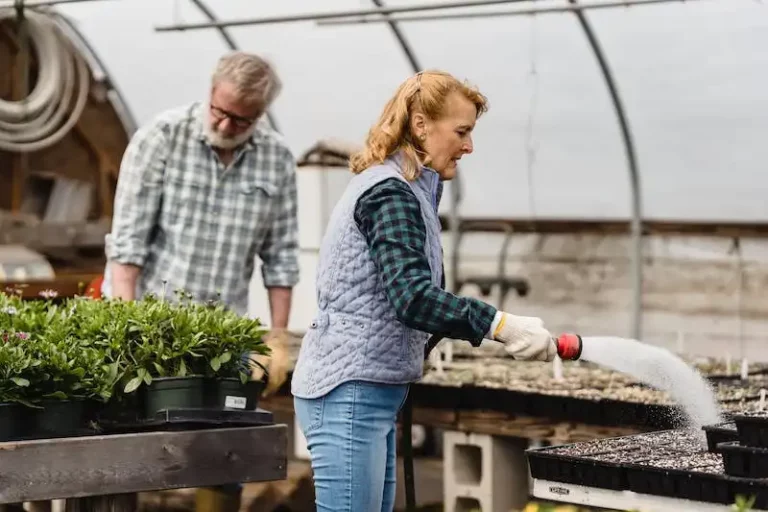When it comes to ordering plants, it’s important to know what to expect. Bare root perennials are a very popular choice for many gardens. These plants are sold without soil, with their roots wrapped in plastic or placed in a damp material like peat moss. But how do you know when and how to plant these root perennials? Let’s take a closer look at the process and what you can expect when ordering them.
First, it’s important to thoroughly inspect the roots of your bare root perennials. Check for any damage or soft spots and trim away any unhealthy or damaged roots. This will help ensure that your plants have a strong foundation to grow from. You can soak the roots in water for a few hours before planting to hydrate them and promote new growth.
Once your bare root perennials are ready to be planted, find a suitable location in your garden. Make sure the soil is well-drained and not too heavy. Dig a hole that is deep enough to accommodate the roots, with enough room for them to spread out. Keep in mind that some perennials have taproots, so it’s important to dig deep enough to accommodate them.
When planting bare root perennials, it’s best to mound up the soil at the base of the plant. This helps to keep the roots moist and prevents them from drying out. It’s also a good idea to add some compost or organic matter to the soil to provide additional nutrients for the plants.
After planting, it’s important to water your bare root perennials thoroughly. Give them a good soaking and make sure the soil is damp. This helps to settle the soil around the roots and promotes healthy growth. Additionally, it’s a good idea to mulch around the plants to help retain moisture and suppress weeds.
Once your bare root perennials are in the ground, it’s important to know what to expect. These plants may take some time to establish and start growing. It’s normal for them to look dormant or show little growth for the first few weeks after planting. However, with proper care and attention, they will soon start to grow and flourish.
Keep in mind that bare root perennials are unique and may require different care than potted or container-grown plants. They have delicate root systems that can easily dry out, so it’s important to water them regularly, especially during dry periods. If you’re growing berries or fruit trees, it’s also important to stake them properly to provide support for the heavy fruit.
In conclusion, bare root perennials are a popular choice for many gardeners. They offer a cost-effective way to grow a wide variety of plants and can be planted directly into the garden. By following these tips from Neda Simeonova, you can ensure that your bare root perennials have the best chance of success and will soon be thriving in your garden.
The Bare Necessities Everything You Need To Know About Bare-Root Plants
In this article, we will discuss everything you need to know about bare-root plants. When you purchase bare-root plants, they typically come without soil, wrapped in plastic, and with their roots exposed. These plants are commonly sold by nurseries and they offer several advantages over potted plants.
One benefit of bare-root plants is that they are usually less expensive than potted plants. They are also easier to transport and store, as they take up less space and are lighter in weight. When you receive bare-root plants, it’s important to inspect them carefully. Look for healthy, young plants with firm, fleshy roots. If the roots appear dry or damaged, it’s best to return the plants to the nursery.
Before planting bare-root perennials or trees, it’s important to prepare your garden beds. Dig a hole deep enough to accommodate the roots, usually about half the height of the plant. Loosen the soil at the base of the hole and, if necessary, amend it with organic material or sand to improve drainage. Once your garden bed is prepared, you can proceed with planting the bare-root plants.
When planting bare-root plants, it’s important to position them correctly. Make sure that the base of the plant is level with the soil surface. If the plant is too deep, the roots may rot, and if it’s too shallow, the plant may dry out. Once the plant is positioned correctly, backfill the hole with soil and firmly press it around the roots. Water the newly planted bare-root plant thoroughly to ensure that the soil is damp.
After planting, bare-root perennials and trees require special care. They should be watered regularly, especially during dry spells, and fertilized as needed. It’s also important to protect young bare-root plants from extreme weather conditions, such as strong winds or heavy rain. Staking the plants or providing a protective cover can help prevent damage.
In conclusion, bare-root plants offer a cost-effective and convenient option for gardeners. By following the proper planting and care instructions, you can successfully grow and enjoy these plants in your garden.
What is Bare Root
Bare root refers to a type of planting where plants or trees are removed from the ground while they are dormant and their roots are exposed, rather than being potted in soil. This method allows for easier transportation, storage, and handling of plants.
During the growing season, plants are usually grown in nurseries with irrigation systems and plastic pots. However, when it comes to bare root plants, they are dug up, carefully inspected, and their roots are washed to remove any excess soil. This process is typically done during a specific period when the plants are dormant, usually in late fall or early spring, depending on the type of plant.
Planting bare root perennials has several advantages. First, it allows for easy inspection of the roots to determine if there are any diseases or abnormalities. Second, it reduces the risk of transplant shock, as the roots are not disturbed or damaged during the digging process. Third, bare root plants are typically less expensive compared to potted or container-grown plants, making them a cost-effective option for large-scale planting.
When planting bare root perennials, it is important to know how to handle them properly. Start by inspecting the roots, making sure they are healthy and free from any diseases. Soak the roots in a bucket of water for about half an hour before planting. Trim any damaged or broken roots and make a small mound of soil in the planting hole to support the plant. Firmly press the soil around the roots to eliminate any air pockets.
Keeping the soil around the newly planted bare root perennials consistently damp is crucial, especially during the first few weeks after planting. This helps the roots establish and reduces the chance of transplant shock. Water the plants deeply, but avoid overwatering, as it can lead to root rot.
In order to encourage growth and establishment, it is recommended to apply a slow-release fertilizer after planting and throughout the growing season. This will provide the necessary nutrients for the plants to thrive.
The surrounding weather conditions also play a significant role in the success of planting bare root perennials. It is best to plant them when the soil is moist but not soggy, and the temperatures are cool. This allows the roots to settle in without being stressed by extreme heat or cold.
Overall, bare root planting is a suitable method for establishing new fruit trees, perennials, and other plants on a farm or in a garden. However, it is important to be careful when ordering bare root plants, as there are some disadvantages to this method as well.
One key disadvantage is that bare root plants have a limited root mass compared to potted plants. This means that they may take longer to establish and require more care during the initial growing period. Additionally, bare root plants cannot be kept out of soil for too long, as they can dry out quickly and become less likely to survive.
However, with proper handling and care, bare root planting can be a successful way to transplant trees and perennials. It offers many advantages, such as ease of transportation, cost savings, and the ability to inspect and amend the roots directly. By following the proper techniques and providing the necessary care, bare root plants have the potential to grow into healthy and thriving additions to any garden or landscape.
Why Bare Root
When it comes to planting roses, shrubs, and perennials, bare root is a popular choice among gardeners. There are several advantages to choosing bare root over potted plants.
One of the main advantages is the cost. Bare root plants are often less expensive than potted plants because they are lighter and easier to ship. This can be especially beneficial if you’re planting a large number of plants or have a limited budget.
Another advantage is that bare root plants have a larger root system compared to potted plants. The roots are not confined to a small pot, allowing them to spread out more freely. This can lead to faster growth and healthier plants in the long run.
When you receive a bare root plant, it may look like a mass of roots with a crooked “taproot” in the middle. This taproot is the main root of the plant and is responsible for anchoring it in the ground. It’s important to be careful when planting to ensure that the taproot is positioned correctly and not bent or broken.
Bare root plants are also easier to transplant. Since they don’t have any soil or pots to contend with, it’s simpler to transfer them directly into your garden or a larger pot. This can save you time and effort, especially if you have a large garden or a lot of plants to transplant.
In addition, bare root plants have a wider window for planting. They can be planted as soon as the soil is workable, which is often earlier than the planting window for potted plants. This can help you get a head start on your garden and enjoy your plants sooner.
When planting bare root plants, it’s important to dig a hole that is wide and deep enough to accommodate the roots. The hole should be cone-shaped, with the wider end at the top and the narrower end at the bottom. This allows the roots to spread out and grow more easily.
Before planting, you may need to amend the soil with compost or other organic matter to provide nutrients for the plant. This will help the plant establish itself and grow more quickly. Fertilizing may also be necessary to ensure the plant receives the proper nutrients.
After planting, it’s important to water the plant deeply to encourage the roots to grow. This will help the plant become established and avoid stress. Regular irrigation is also important to ensure the plant receives enough water, especially during hot and dry periods.
In summary, bare root plants offer several advantages over potted plants. They are often less expensive, have larger root systems, are easier to transplant, and have a wider planting window. By following proper planting and care techniques, you can enjoy the abundance of roses, shrubs, and perennials that bare root plants can offer to your garden.



